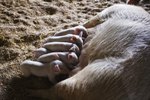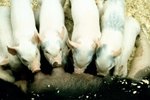
Heifers reach puberty about the time of their first birthday -- a few weeks earlier for some breeds and a few weeks later for others. At the time of that first heat cycle, heifers are about 65 percent of their adult weight. With their nine-month gestation periods, heifers bred on their initial estrous cycles give birth at the age of approximately 18 months. Once they give birth, they're no longer heifers; they're cows.
Weight Gain
Between the time she's bred and the day she first gives birth, the heifer gains a considerable amount of weight. Part of this is because of her pregnancy, while part is just normal maturation and growth. If she's 65 percent of her adult weight at insemination, she should reach 85 percent of that weight by the time of first calving. For the average heifer, that means a weight gain of 1 pound daily throughout the pregnancy.
Udder Development
One of the most obvious changes in the heifer's body as calving time draws near is her udder development. About two months before calving, the teats of her udder begin filling. That happens much later in the pregnancy for an older cow who has previously given birth. The heifer's udder continues to enlarge due to elongation of her mammary ducts and formation of alveoli -- small, milk-secreting sacs. Shortly before calving, she might begin dripping milk from her teats.
Pelvic Area
The pelvic area must expand considerably during the heifer's pregnancy in order for her to safely deliver her calf. According to Ohio State University Extension, the average yearling heifer's pelvic area ranges between 55 and 66 inches across. By the time of calving, her pelvic are should range between 70 to 78 inches. Heifers with smaller pelvic areas might require Caesarean sections. Your vet can accurately measure the pelvic area before you breed your heifers using specially designed pelvic meters.
Calving
The first calf is often the most difficult, because of the heifer's inexperience and not completely mature body. When labor starts, she becomes restless, separating herself from the herd. She might refuse to eat. When her water breaks, hard labor begins, as the calf enters the birth canal. According to Hereford World, if a heifer is in hard labor for more than one hour without delivery, human assistance is needed. If the calf's feet and nose show at the vulva but there's no progression, it's possible the heifer has a persistent hymen. That's a band of tissue just inside the birth canal. Since heifers are bred by artificial insemination, there's no real breaking of that hymen during mating, as occurs naturally. Although breakage is painful, it must be done to get the calf out. At this point, most calves must be pulled from the heifer -- now a cow.
References
- Victoria Department of Environment and Primary Industries: Heifer Nutrition From Weaning to First Calving
- University of Illinois Extension: Mammary Development in Heifers
- Hereford World: Calving Out Heifers
- Iowa Beef Center: Management of First-Calf Heifers
- Ohio State University: Integrated Heifer Management - Critical Success Factors
- Iowa Beef Center: Pelvic Measurements for Reducing Calving Difficulty
- Extension: At What Age Does a Female Calf Become a Cow?
Photo Credits
-
Digital Vision./Digital Vision/Getty Images
Writer Bio
Jane Meggitt has been a writer for more than 20 years. In addition to reporting for a major newspaper chain, she has been published in "Horse News," "Suburban Classic," "Hoof Beats," "Equine Journal" and other publications. She has a Bachelor of Arts in English from New York University and an Associate of Arts from the American Academy of Dramatics Arts, New York City.



